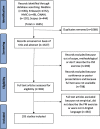Process mapping in healthcare: a systematic review
- PMID: 33853610
- PMCID: PMC8048073
- DOI: 10.1186/s12913-021-06254-1
Process mapping in healthcare: a systematic review
Abstract
Introduction: Process mapping (PM) supports better understanding of complex systems and adaptation of improvement interventions to their local context. However, there is little research on its use in healthcare. This study (i) proposes a conceptual framework outlining quality criteria to guide the effective implementation, evaluation and reporting of PM in healthcare; (ii) reviews published PM cases to identify context and quality of PM application, and the reported benefits of using PM in healthcare.
Methods: We developed the conceptual framework by reviewing methodological guidance on PM and empirical literature on its use in healthcare improvement interventions. We conducted a systematic review of empirical literature using PRISMA (Preferred Reporting Items for Systematic Reviews and Meta-Analyses) methodology. Inclusion criteria were: full text empirical study; describing the process through which PM has been applied in a healthcare setting; published in English. Databases searched are: Medline, Embase, HMIC-Health Management Information Consortium, CINAHL-Cumulative Index to Nursing and Allied Health Literature, Scopus. Two independent reviewers extracted and analysed data. Each manuscript underwent line by line coding. The conceptual framework was used to evaluate adherence of empirical studies to the identified PM quality criteria. Context in which PM is used and benefits of using PM were coded using an inductive thematic analysis approach.
Results: The framework outlines quality criteria for each PM phase: (i) preparation, planning and process identification, (ii) data and information gathering, (iii) process map generation, (iv) analysis, (v) taking it forward. PM is used in a variety of settings and approaches to improvement. None of the reviewed studies (N = 105) met all ten quality criteria; 7% were compliant with 8/10 or 9/10 criteria. 45% of studies reported that PM was generated through multi-professional meetings and 15% reported patient involvement. Studies highlighted the value of PM in navigating the complexity characterising healthcare improvement interventions.
Conclusion: The full potential of PM is inhibited by variance in reporting and poor adherence to underpinning principles. Greater rigour in the application of the method is required. We encourage the use and further development of the proposed framework to support training, application and reporting of PM.
Trial registration: Prospero ID: CRD42017082140.
Keywords: Health care; Improvement; Mapping; Methods; Process; Quality; Systematic review.
Conflict of interest statement
The authors declare that they have no competing interests.
Figures




References
-
- Reason J. Human error. 1 edition. Cambridge England. New York: Cambridge University Press; 1991.
Publication types
MeSH terms
Grants and funding
LinkOut - more resources
Full Text Sources
Other Literature Sources
Medical
Miscellaneous

